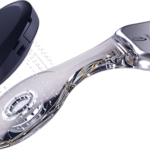Cochlear™ Baha® abutment length
Selecting the appropriate abutment length based on the measured tissue thickness is an essential step during the surgical procedure.
Skin thickness measurement: It’s vital to measure the skin tissue thickness at the expected implant site. Further, it’s important to note that body mass index (BMI) is not a good predictor of skin tissue thickness. When measuring, use a small gauge needle and a clamp; do not depress the skin tissue while measuring, doing so may skew the measurement. Local anesthetic should be administered AFTER skin tissue measurement.
After confirming the approximate tissue thickness against a ruler, add 3mm to determine the abutment length. When the measurement yields an uneven number, round up to the larger abutment to ensure a positive outcome. The hydroxyapatite (HA) coating (white portion) is intended to be in contact with the tissue. In some patients the HA coating may be slightly visible. This will not impact the outcome.
Because the tissue thickness is not known until the time of surgery, it is advisable to have multiple abutment lengths available for each surgery to accommodate individual anatomies.

The importance of DermaLock™
The Baha® Connect System is a percutaneous bone conduction implant system allowing direct, single-point sound transmission via a minimally invasive skin-penetrating abutment.
Conventional titanium abutments have been used for 40 years, but despite the metal’s well established ability to osseointegrate with bone, it does not integrate with the surrounding tissue. As a result, bone conduction implant surgery previously involved substantial soft tissue reduction to facilitate successful outcomes. Consequently, viable structures of the soft tissue were permanently removed, affecting the healing capacity of the local immune system. The Baha BA400 Abutment with DermaLock™ technology features a plasma-sprayed hydroxyapatite (HA) coating and concave design that promotes soft tissue adherence and stability.1
Hydroxyapatite (HA) provides enhanced dermal adhesion, diminishing epidermal downgrowth and pocket formation, thus allowing for preservation of the soft tissue during surgery. This technology helps preserve the hair and skin around the abutment which not only leads to improved aesthetics and reduced numbness, but also dramatically reduces surgery time and benefits healing through increased vascularization of soft tissue.2

What is implant stability and why does it matter?
Dating back to the 1950s, Swedish Professor Branemark pioneered the study of titanium and its osseointegration qualities. His research was advanced by Dr. Anders Tjellstrom’s work on bone conduction hearing implants. Throughout the decades, titanium has served as the metal of choice for hearing implants.
The BI300 implant utilizes the TiOblast™ surface for faster/stronger osseointegration and secondary stability when compared to previous implants. It has small threads at the neck of the implant for optimal load distribution and a wider profile of 4.5mm to optimize strength of the system. These attributes allow clinically proven long-term stability.3, 4 The chart below shows 5-year follow up data of primary and long-term strength of osseointegration with the Baha 300 Series implant. 3, 4
Primary and long-term strength of osseointegration with the Baha 300 Series implant
Figure 1: Primary and long-term strength of osseointegration with the Baha 300 Series Implant

The data on the graph (Figure 1) supports that patients with Connect or Attract benefit the most from our most advanced titanium bone conduction implant available, the BI300. The “Test” implant represents the BIA300 abutment with the BI300 Implant, and the “Control” implant is a previous generation titanium flange fixture from Cochlear.
Cochlear drill handpiece cleaning and maintenance
The proper cleaning and maintenance of your Cochlear drill handpiece will ensure the smooth operation of your Cochlear Drill and avoid the inconvenience of any unneeded repairs. The recommended cleaning and lubrication is consistent with a properly functioning Cochlear drill and may extend the life of your drill.

Want to see more? Subscribe to Cochlear ProNews to ensure you receive new post notifications!
References:
- van Hoof M, Wigren S, Duimel H, Savelkoul PH, Flynn M, Stokroos RJ. Can the Hydroxyapatite-Coated Skin-Penetrating Abutment for Bone Conduction Hearing Implants Integrate with the Surrounding Skin? Front Surg. 2015;2:45.
- Iseri M, Orhan KS, Yariktas MH, Kara A, Durgut M, Ceylan DS, Guldiken Y, Keskin IG, Deger K. Surgical and audiological evaluation of the Baha BA400. J Laryngol Otol. 2015;129(1):32-37.
- den Besten CA, Stalfors J, Wigren S, Blechert JI, Flynn M, Eeg-Olofsson M, Aggarwal R, Green K, Nelissen RC, Mylanus EA, Hol MK. Stability, Survival, and Tolerability of an Auditory Osseointegrated Implant for Bone Conduction Hearing: Long-Term Follow-Up of a Randomized Controlled Trial. Otol Neurotol. 2016;37(8):1077-1083.
- Sennerby L, Gottlow J, Rosengren A, Flynn M. An experimental evaluation of a new craniofacial implant using the rabbit tibia model: Part II. Biomechanical findings. Otol Neurotol. 2010;31(5):840-845.


